I've always loved this "explaining The Searchers" scene from Martin Scorsese's Who's That Knocking At My Door? ('68). Filmed in '65, the 26-year-old Harvey Keitel is trying to make Zina Bethune, 20, with his knowledge of and passion for John Ford's The Searchers (5.16.56).
Login with Patreon to view this post
Woody Allen‘s Rifkin’s Festival is about (a) a couple who both cat around on each other (i.e., fall for someone else) while attending the San Sebastián Film Festival and (b) the same four people, in the midst of this romantic adventurism, talking, thinking and behaving like Woody or, you know, quintessential Woody characters.
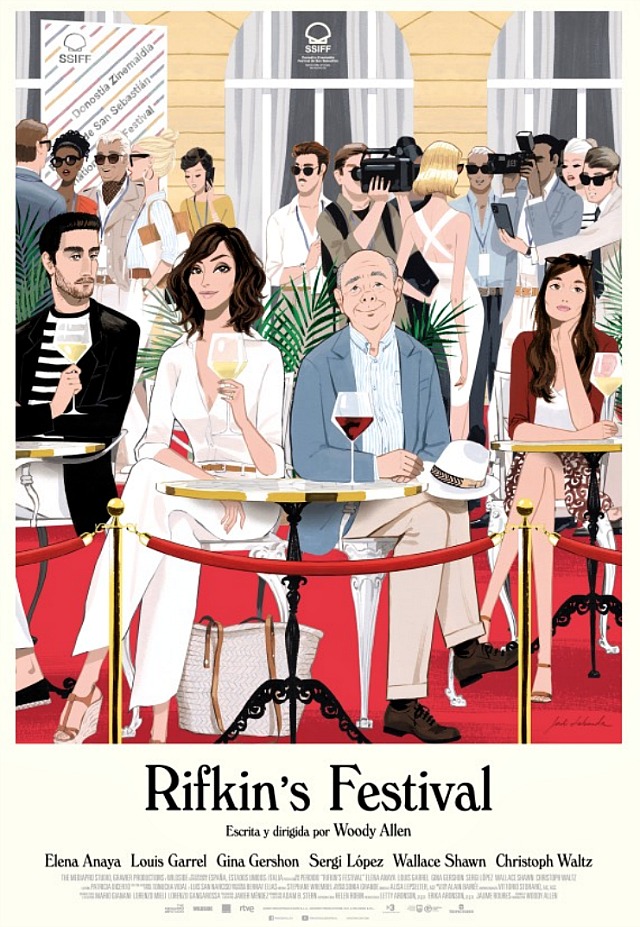
An HE reader is looking for copies of Memphis (Paul Greengrass‘s draft), The Girl with the Dragon Tattoo, Lord of Salem, Triple Frontier, Rock of Ages, Dark Shadows, Aryan Papers, Wartime Lies, 20000 Leagues Under the Sea (Scott Burns), The Reincarnation of Peter Proud, Lincoln (Tony Kushner draft only), The Talking Cure (a.k.a A Dangerous Method), Ant-Man (Edgar Wright) and War Horse. So am I. Anyone?
This guy has copies-to-trade of Cogan’s Trade, Cosmopolis (David Cronenberg), Moonrise Kingdom (Wes Anderson), Silence (Jay Cocks/Scorsese), The Last Photograph, Moneyball (latest draft by Zaillian and Sorkin), Drive, The Invention of Hugo Cabret, The Irishman (Steven Zaillian/Scorsese), Tinker Tailor Soldier Spy (Peter Morgan), Django Unchained, The Master (Paul Thomas Anderson), Down by Law (Jim Jarmusch), Ace in the Hole (David Mamet draft), Four Queens (David Mamet), Ordinary Daylight (David Mamet), Charlie Chan in Horse and Rider (David Mamet), Autobiography of Malcolm X (David Mamet), Hunger (Steve McQueen), Shame (Steve McQueen), Dino (Nicholas Pileggi/Scorsese), Twilight Zones (David Chase), Getting Out (Sidney Lumet), Godless (Scott Frank), A Walk Among the Tombstones (two drafts by Scott Frank), Knockout (Soderbergh), Peach Trees aka Dredd (Alex Garland), Tree of Life (Terrence Malick), 36 aka Animals (Richard Price), Wolf of Wall Street (Scorsese), Curveball (Steven Knight), Cloud Atlas (Wachowski Bros/Tykwer draft), Confederacy of Dunces (Steven Soderbergh), Don’t Be Afraid of the Dark, Gambit (Coen Bros.), Cuba Libre (Coen Bros.), God of Carnage (Roman Polanski), Hoover (Dustin Lance Black/Clint Eastwood),Lone Ranger (Ted Elliott/Terry Rossio), Rosenthaler Suite (Wes Anderson), 77 (James Ellroy), Trial of the Chicago 7 (Aaron Sorkin), We Need To Talk About Kevin (Lynne Ramsay), Young Adult (Diablo Cody) and Wettest County in the World (John Hillcoat).

I’m ready and willing to ease up on my John Ford takedowns and I could really and truly go the rest of my life without writing another word (much less another article) on The Searchers. But yesterday the Hollywood Reporter posted a Martin Scorsese essay on The Searchers — mostly a praise piece — and I feel obliged to respond, dammit. But really, this is the end.
Scorsese’s basic thought is that while The Searchers has some unfortunate or irritating aspects, it’s nonetheless a great film and has seemed deeper, more troubling and more layered the older he’s become. Which is well and good but you always have to take Scorsese’s praise with a grain of salt, I think. A lifelong Film Catholic, Scorsese has always been a gentle, generous, big-hearted critic. Show him almost any mediocre film by a semi-respected director and nine times out of ten he’ll look on the bright side and turn the other cheek. Has he ever written anything even the least bit mean or cutting or dismissive?
My basic view of The Searchers, as I wrote three of four years ago, is that “for a great film it takes an awful lot of work to get through it. I don’t know how to enjoy The Searchers any more except by wearing aesthetic blinders — by ignoring all the stuff that drives me up the wall in order to savor the beautiful heartbreaking stuff (the opening and closing shot, Wayne’s look of fear when he senses danger for his brother’s family, his picking up Wood at the finale and saying, ‘Let’s go home, Debbie’). That said I can’t help but worship Winston C. Hoch‘s photography for its own virtues.
For me, Scorsese’s wisest observation is that John Ford personally related to John Wayne‘s Ethan Edwards, the gruff, scowling, racist-minded loner at the heart of this 1956 film.
Ford “was at his lowest ebb” when he made The Searchers, Scorsese writes. “Ford’s participation in the screen version of Mister Roberts had ended disastrously soon after a violent encounter between the filmmaker and his star Henry Fonda. For Ford, The Searchers was more than just another picture: It was his opportunity to prove that he was still in control. Did he pour more of himself into the movie? It does seem reasonable to assume that Ford recognized something of his own loneliness in Ethan Edwards and that the character sparked something in him. It’s interesting to see how it dovetails with another troubled character from the same period. Like James Stewart‘s Scotty in Vertigo, Edwards’ obsessive quest ends in madness.”
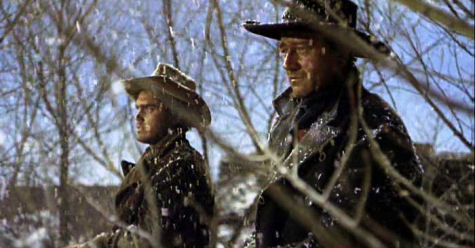
Jeffrey Hunter, John Wayne
Film lovers know The Searchers “by heart,” Scorsese writes, “but what about average movie watchers? What place does John Ford’s masterpiece occupy in our national consciousness?” Wells to Scorsese: In terms of the consciousness of the general public, close to zilch. In terms of the big-city Film Catholic community (industry aficionados, entertainment journalists, film academics and devoted students, educated and well-heeled film buffs, obsessive film bums), there is certainly respect for The Searchers but true passionate love? The numbers of those who feel as strongly as you, most of whom grew up in the ’50s and ’60s, are, I imagine, relatively small and dwindling as we speak.
I’m pleased to note that some of my complaints about Ford have at least been acknowledged by Scorsese. “A few years ago I watched it with my wife,” he writes, “and I will admit that it gave me pause. Many people have problems with Ford’s Irish humor, which is almost always alcohol-related. For some, the frontier-comedy scenes with Ken Curtis are tough to take.
“For me, the problem was with the scenes involving a plump Comanche woman (Beulah Archuletta) that the Hunter character inadvertently takes as a wife. There is some low comedy in these scenes: Hunter kicks her down a hill, and Max Steiner’s score amplifies the moment with a comic flourish. Then the tone shifts dramatically, and Wayne and Hunter both become ruthless and bullying, scaring her away. Later, they find her body in a Comanche camp that has been wiped out by American soldiers, and you can feel their sense of loss. All the same, this passage seemed unnecessarily cruel to me.”
Here’s what I wrote way back when:
“John Ford‘s movies have been wowing and infuriating me all my life. A first-rate visual composer and one of Hollywood’s most economical story-tellers bar none, Ford made films that were always rich with complexity, understatements and undercurrents that refused to run in one simple direction.
“Ford’s films are always what they seem to be…until you watch them again and re-reflect, and then they always seem to be about something more. But the phoniness and jacked-up sentiment in just about every one of them can be oppressive, and the older Ford got the more he ladled it on.
“The Irish clannishness, the tributes to boozy male camaraderie, the relentless balladeering over the opening credits of 90% of his films, the old-school chauvinism, the racism, the thinly sketched women, the “gallery of supporting players bristling with tedious eccentricity” (as critic David Thomson put it in his Biographical Dictionary of Film) and so on.
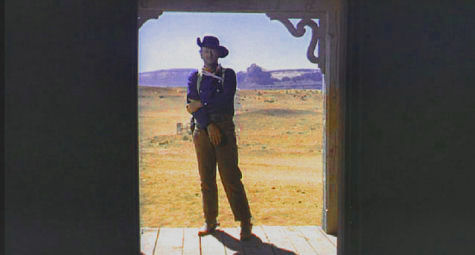
The closing shot of John Ford’s The Searchers
“The treacliness is there but tolerable in Ford’s fine pre-1945 work — The Informer, Stagecoach, Young Mr. Lincoln , Drums Along the Mohawk, They Were Expendable , The Grapes of Wrath and My Darling Clementine .
“But it gets really thick starting with 1948’s Fort Apache and by the time you get to The Searchers, Ford’s undisputed masterpiece that came out in March of 1956, it’s enough to make you yank the reins and go ‘whoa, nelly.’
“Watch the breathtaking beautiful new DVD of The Searchers, and see if you can get through it without choking. Every shot is a visual jewel, but except for John Wayne‘s Ethan Edwards, one of the most fascinating racist bastards of all time, every last character and just about every line in the film feels labored and ungenuine.
“The phoniness gets so pernicious after a while that it seems to nudge this admittedly spellbinding film toward self-parody. Younger people who don’t ‘get’ Ford (and every now and then I think I may be turning into one) have been known to laugh at it.
“Jeffrey Hunter‘s Martin Pawley does nothing but bug his eyes, overact and say stupid exasperating lines all through the damn thing. Nearly every male supporting character in the film does the same. No one has it in them to hold back or play it cool — everyone blurts.
“Ken Curtis‘s Charlie McCorry, Harry Carey Jr.’s Brad Jorgensen, Hank Worden‘s Mose Harper…characters I’ve come to despise.
“You can do little else but sit and grimace through Natalie Wood‘s acting as Debbie (the kidnapped daughter of Ethan’s dead brother), Vera Miles‘ Laurie Jorgenson, and Beulah Archuletta‘s chubby Indian squaw (i.e., ‘Wild Goose Flying in the Night Sky’)…utterly fake in each and every gesture and utterance.
“I realize there’s a powerful double-track element in the racism that seethes inside Ethan, but until he made Cheyenne Autumn Ford always portrayed Indians — Native Americans — as creepy, vaguely sadistic oddballs. The German-born, blue-eyed Henry Brandon as Scar, the Comanche baddie…’nuff said.
“That repulsive scene when Ethan and Martin look at four or five babbling Anglo women whose condition was caused, we’re informed, by having been raised by Indians, and some guy says, ‘Hard to believe they’re white’ and Ethan says, ‘They ain’t white!’
“I’ll always love the way Ford handles that brief bit when Ward Bond‘s Reverend Clayton sees Martha, the wife of Ethan’s brother, stroking Ethan’s overcoat and then barely reacts — perfect — but every time Bond opens his mouth to say something, he bellows like a bull moose.”
Final thought: The more I think about the stuff in Ford’s films that drives me crazy, the less I want to watch any Ford films, ever. Okay, that’s not true but the only ones I can stand at this point are The Horse Soldiers, The Man Who Shot Liberty Valance, The Grapes of Wrath, The Informer, The Lost Patrol, The Last Hurrah and, believe it or not, Donovan’s Reef.
I feel nothing but admiration and affection for Peter Bogdanovich, and I’ve been enjoying his Indiewire “Blogdanovich” columns all along. But his 8.9 praise piece about John Ford‘s The Searchers doesn’t feel especially fresh and in fact has a tired pulse. Bogdanovich is a Ford scholar par excellence, of course, but we’ve been hearing this same old stuff about The Searchers for decades (“not only among the very best, but also among the final Western masterworks of the movies’ golden age”). So why re-state it?
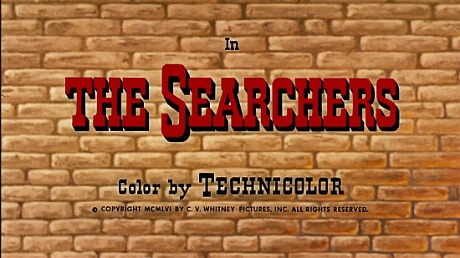
The first significant “take a fresh look at The Searchers” piece was written 32 years ago by New York contributor Stuart Byron. In it he called Ford’s 1956 film the “Super-Cult Movie of the New Hollywood.” And here we still are in the Age of Withered Obama, and The Searchers Bluray is a ripe and luscious thing to have and hold. We get it, we get it. Or I certainly do.
Here’s a counter-punch piece I posted a little more than five years ago:
“John Ford‘s movies have been wowing and infuriating me all my life. A first-rate visual composer and one of Hollywood’s most economical story-tellers bar none, Ford made films that were always rich with complexity, understatements and undercurrents that refused to run in one simple direction.
“Ford’s films are always what they seem to be…until you watch them again and re-reflect, and then they always seem to be about something more.
“But the phoniness and jacked-up sentiment in just about every one of them can be oppressive, and the older Ford got the more he ladled it on.
“The Irish clannishness, the tributes to boozy male camaraderie, the relentless balladeering over the opening credits of 90% of his films, the old-school chauvinism, the racism, the thinly sketched women, the “gallery of supporting players bristling with tedious eccentricity” (as critic David Thomson put it in his Biographical Dictionary of Film) and so on.

The closing shot of John Ford’s The Searchers
“The treacliness is there but tolerable in Ford’s fine pre-1945 work — The Informer, Stagecoach, Young Mr. Lincoln , Drums Along the Mohawk, They Were Expendable , The Grapes of Wrath and My Darling Clementine .
“But it gets really thick starting with 1948’s Fort Apache and by the time you get to The Searchers, Ford’s undisputed masterpiece that came out in March of 1956, it’s enough to make you yank the reins and go ‘whoa, nelly.’
“Watch the breathtaking beautiful new DVD of The Searchers, and see if you can get through it without choking. Every shot is a visual jewel, but except for John Wayne‘s Ethan Edwards, one of the most fascinating racist bastards of all time, every last character and just about every line in the film feels labored and ungenuine.
“The phoniness gets so pernicious after a while that it seems to nudge this admittedly spellbinding film toward self-parody. Younger people who don’t “get” Ford (and every now and then I think I may be turning into one) have been known to laugh at it.
“Jeffrey Hunter‘s Martin Pawley does nothing but bug his eyes, overact and say stupid exasperating lines all through the damn thing. Nearly every male supporting character in the film does the same. No one has it in them to hold back or play it cool — everyone blurts.
“Ken Curtis‘s Charlie McCorry, Harry Carey Jr.’s Brad Jorgensen, Hank Worden‘s Mose Harper…characters I’ve come to despise.
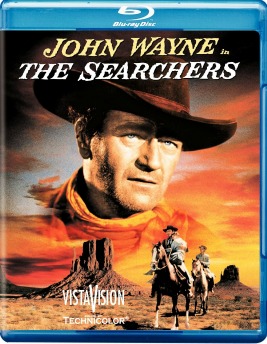
“I’ll always love the way Ford handles that brief bit when Ward Bond‘s Reverend Clayton sees Martha, the wife of Ethan’s brother, stroking Ethan’s overcoat and then barely reacts — perfect — but every time Bond opens his mouth to say something, he bellows like a bull moose.
“You can do little else but sit and grimace through Natalie Wood‘s acting as Debbie (the kidnapped daughter of Ethan’s dead brother), Vera Miles‘ Laurie Jorgenson, and Beulah Archuletta‘s chubby Indian squaw (i.e., “Wild Goose Flying in the Night Sky”)…utterly fake in each and every gesture and utterance.
“I realize there’s a powerful double-track element in the racism that seethes inside Ethan, but until he made Cheyenne Autumn Ford always portrayed Indians — Native Americans — as creepy, vaguely sadistic oddballs. The German-born, blue-eyed Henry Brandon as Scar, the Comanche baddie at the heart of The Searchers…’nuff said.
“That repulsive scene when Ethan and Martin look at four or five babbling Anglo women whose condition was caused, we’re informed, by having been raised by Indians, and some guy says, “Hard to believe they’re white” and Ethan says, “They ain’t white!”
“I don’t know how to enjoy The Searchers any more except by wearing aesthetic blinders — by ignoring all the stuff that drives me up the wall in order to savor the beautiful heartbreaking stuff (the opening and closing shot, Wayne’s look of fear when he senses danger for his brother’s family, his picking up Wood at the finale and saying, ‘Let’s go home, Debbie’).
“All I’m saying is, for a great film it takes an awful lot of work to get through it.”

Jeffrey Hunter, John Wayne
Someone else has finally written a strong gripe piece about John Ford‘s The Searchers. The author is Stephen Metcalf, and his article ran yesterday (Thursday, 7.6) on Slate. I took a stab at expressing my divided feelings about Ford and his post-1948 westerns in a piece that I ran in mid-June. (Apologies for last night’s Slate/Salon mixup.)

If Sonny Bono hadn’t slammed into a tree while skiiing in the Lake Tahoe region on 1.5.98 and if he’d otherwise kept himself in good health, he would have celebrated his 88th birthday five days ago (2.16.23).
Bono was 64 at the time of his death. I’m sorry he suffered through that. But he lived an interesting life with an unusual arc — at first a hippie-ish songwriter, singer and performer in the ’60s and ’70s, and then a “protect the small businessman” Republican in the ’80s and ’90s.
An early ’80s memory: I was driving west along the hilly-curvy section of Sunset Blvd. (near Hugh Hefner’s Playboy mansion) when I noticed Bono in his car, waiting to slip into the eastbound lane.
Two or three years later I ordered a drink at Bono, his Italian joint on Melrose near La Cienega. My immediate impression was that there were too many tables scrunched together.
I’m mentioning Bono because until this morning I somehow hadn’t read that he and Roddy Jackson co-authored “She Said ‘Yeah!’“, a fast and catchy Rolling Stones song from ‘64 or ‘65. The song is basically a horndog thing — a lust-struck guy wants to have it off with a hot girl, and to his infinite delight she’s down for it… “yeah!”**
I’d also never read that Bono co-authored “Needles and Pins,” a 1962 song that took off when a version by The Searchers charted in ’64. Bono co-penned the song with Jack Nitzsche and Jackie DeShannon, who recorded a version in ’63. The song is more commonly known as “Needles and Pinzah.”
We all understand that first-class Blurays of 1950s big-studio features that were captured on large-format celluloid (VistaVision, Cameras 65, Technirama, Super Panavision, etc.) are glorious eye candy.
Login with Patreon to view this post
Ari Aster‘s Disappointment Blvd. — a very cool, take-it-or-leave-it smarthouse title, one that sticks to your ribs — is no longer being called Disappointment Blvd. The new title, according to A24, is Beau Is Afraid — presumably an allusion to the first name of Joaquin Phoenix‘s main protagonist, “one of the most successful entrepreneurs of all time.”
Beau Is Afraid is obviously a wimpy-sounding title. It was presumably chosen to appeal to Millennial and Zoomer “safeties”, or basically your under-40 lily-livered types who live in various states of perpetual anxiety and have frequently shared concerns online about not feeling safe enough. We’re talking about gentle reed candy-asses with peep-peep pussy voices and squeaky shoes…intimidated types who wear baggy jeans and normcore clothing…this is your target audience for Beau Is Afraid.
In a simultaneous decision, A24 has announced that The Whale it also being retitled. Darren Aronofsky‘s film will now be called Brendan Fraser Isn’t Attending the Golden Globes Because He’s Afraid That Phillip Berk Will Once Again Insert A Finger Into Brendan’s Anus.
Let’s re-title various classic films according to the A24 “safety” aesthetic. Point Blank is now called Walker Is Afraid. Sam Peckinpah‘s The Wild Bunch is now called The Fraidy Cats. John Ford‘s The Searchers will henceforth be called Ethan Is Afraid of the Comanches. The title of Steven Spielberg‘s The Fabelmans is now Sammy Is Afraid of Failing As A Filmmaker (And Has Therefore Decided To Live In His Mother’s Basement). We can play this game all day.
I’m afraid, you’re afraid, we’re all afraid. Jordan Ruimy is afraid. Roger Durling is afraid. Larry Karaszewski and Scott Alexander are afraid that they’ll never write another Ed Wood or The People vs. O.J. Simpson. Sasha Stone is afraid. Each and every day David Poland awakes with fear in his soul. Life is full of terror, anxiety and intimidation.


The 2022 Sight & Sound poll popped earlier this afternoon, and we all knew what the results would reflect, right? Not so much with films directed by older white guys (especially OWG directors with a somewhat dicey or shady reputation), and up with films directed by women and POCS. And so Chantal Akerman‘s Jeanne Dielman, 23, quai du Commerce, 1080 Bruxel, a 201-minute film about duty, survival, sex working, regimentation and repetition, and which ends with a “john” getting stabbed in the throat with a pair of scissors, was named #1.
In other words, (a) down with the insensitive asshole patriarchy, (b) up with chopped onions carefully mashed into ground beef, and (c) hooray for Delphine Seyrig finally having an orgasm.
In 2012 Jeanne Dielman ranked #36 on the BFI list…fine. But how did it manage to suddenly vault up to the #1 position? Admired films tend to move up gradually, no? It feels to some of us like Dielman won because of an organized campaign among feminist-minded critics. If Dielman had landed in the 10th or 12th spot in the 2012 poll, today’s win would have seemed more of a natural thing. But to go from 36th place a decade ago to #1 in ’22? It seems to me like the fix was in.

You can’t argue or complain with the BFI critics, who are primarily a bunch of highbrow snoots trying to out-snoot each other.
If you ask me the BFI Directors Greatest Films of All Time list is a lot more grounded and sensible.
So 60th-ranked Moonlight has edged out Casablanca (#61), Goodfellas (#62) and The Third Man (#63). I’ve seen all four, and I’m telling you straight from the shoulder that there’s no way Moonlight deserves, deliberately or haphazardly, to be ranked above the other three…NO WAY ON GOD’S GREEN EARTH.
Alfred Hitchcock‘s Vertigo is now ranked second, and I honestly thought it would take a bigger hit than that. I figured the legend of Hitch having allegedly made Tippi Hedren‘s life hell during the making of The Birds and especially Marnie…okay, let’s drop it, but I’m slightly surprised.
Three indisputably great 20th Century films about conflicted white males dealing with disillusionment and corruption — David Lean’s Lawrence of Arabia (’62), Roman Polanski’s Chinatown (’74) and Sam Peckinpah’s The Wild Bunch (’69) — were booted off the critics’ list of the top 100. Polanski had to pay for his sexual indiscretions of the ’70s and ’80s, I suppose, and Peckinpah had to be banned for his notorious misogyny. But why did the saga of T.E. Lawrence get the shaft? What exactly did Lean or Lawrence do to earn the heave-ho? Was it the old arrogant British imperialism thing, or the fact that women are barely seen and certainly not heard seen in that classic desert epic?
1. “Jeanne Dielman, 23, quai du Commerce, 1080 Bruxel” (Chantal Akerman, 1975)
2. “Vertigo” (Alfred Hitchcock, 1958)
3. “Citizen Kane” (Orson Welles, 1941)
4. “Tokyo Story” (Ozu Yasujiro, 1953)
5. “In the Mood for Love, Wong Kar-wai, 2001)
6. “2001: A Space Odyssey” (Stanley Kubrick, 1968)
7. “Beau travail” (Claire Denis, 1998)
8. “Mulholland Dr.” (David Lynch, 2001)
9. “Man with a Movie Camera” (Dziga Vertov, 1929)
10. “Singin’ in the Rain” (Stanley Donen and Gene Kelly, 1951)
On this, the 59th anniversary of the assassination of JFK in Dallas, World of Reel‘s Jordan Ruimy has posted a recap of a Gangs of New York piece that was titled Gangs vs. Gangs, and which originally appeared in my Movie Poop Shoot column in December 2002.
Here’s my own recap, which I posted on 1.24.18.
I was told earlier today that the Gangs of New York Wikipedia page mentions a noteworthy piece by yours truly, posted in December 2001, that described the differences between a 1.37:1 work print version of Gangs that I saw on VHS vs. the final 2.39:1 release version. Here’s a link to the original article, and here’s a repost of it:
If Miramax Films and Martin Scorsese had decided to release a polished, cleaned-up version of the Gangs of New York work print they had in the can (or, if you want to get technical, that was stored on Marty and editor Thelma Schoonmaker‘s Avid) sometime in October ’01, we’d all be enjoying a better, more rewarding film than the Gangs that will open nationwide four days from now (12.20.02).
I’ve seen both versions and most of you haven’t, so I know something you don’t. The best Gangs of New York will not be hitting screens this weekend, and may never even be seen on DVD, given Scorsese’s apparent disinterest in releasing “director’s cut” versions of his films, or in supplying deleted scenes or outtakes or any of that jazz.
The work-print version is longer by roughly 20 minutes, and more filled out and expressive as a result, but that’s not the thing. The main distinction for me is that it’s plainer and therefore more cinematic, as it doesn’t use the narration track that, in my view, pollutes the official version. It also lacks a musical score, with only some drums and temp music.
This leaves you free, in short, to simply pick and choose from the feast of visual information that Gangs of New York is, and make of it what you will. And if that isn’t the essence of great movie-watching, I don’t know what is.
It also points out what’s wrong with the theatrical release version, which I feel has been fussed over too intensively, compressed, simplified, lathered in big-movie music and, to some extent, thematically obscured.
Miramax and Scorsese had the superior work-print version in their hands 14 months ago. It’s a little rough around the edges, but it’s not tremendously different from the version being released on Friday. It is only missing Leonardo DiCaprio‘s narration, a musical score and some CG effects, which tells me it could have easily been prepared for a December ’01 release. But Miramax decided otherwise and pushed it back it until now. If you ask me their reasons for doing so were short-sighted and wrong.
The most emotionally moving moment in Steven Spielberg‘s The Fabelmans comes when we hear the opening passage from Max Steiner‘s score for John Ford‘s The Searchers. It’s a payoff like no other. I beamed and went “aahh, yes…this hits home, feels right.”


 All Hail Tom White, Taciturn Hero of “Killers of the Flower Moon”
All Hail Tom White, Taciturn Hero of “Killers of the Flower Moon”Roughly two months ago a very early draft of Eric Roth‘s screenplay for Killers of the Flower Moon (dated 2.20.17,...
More » Dead-End Insanity of “Nomadland”
Dead-End Insanity of “Nomadland”Frances McDormand‘s Fern was strong but mule-stubborn and at the end of the day self-destructive, and this stunted psychology led...
More » Mia Farrow’s Best Performances?
Mia Farrow’s Best Performances?Can’t decide which performance is better, although I’ve always leaned toward Tina Vitale, her cynical New Jersey moll behind the...
More »

 Hedren’s 94th
Hedren’s 94thTwo days ago (1.19) a Facebook tribute congratulated Tippi Hedren for having reached her 94th year (blow out the candles!)...
More » Criminal Protagonists
Criminal ProtagonistsA friend suggested a list of the Ten Best American Crime Flicks of the ‘70s. By which he meant films...
More » “‘Moby-Dick’ on Horseback”
“‘Moby-Dick’ on Horseback”I’ve never been able to give myself over to Sam Peckinpah’s Major Dundee, a 1965 Civil War–era western, and I’ve...
More »


